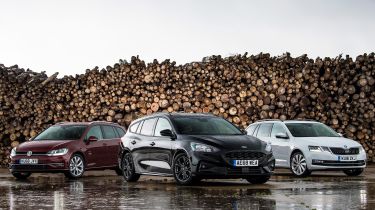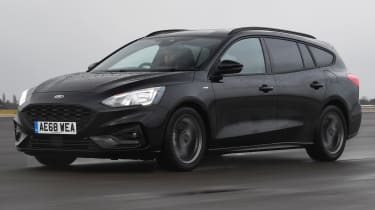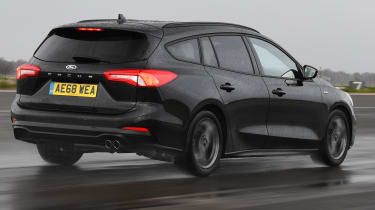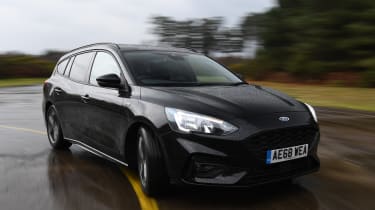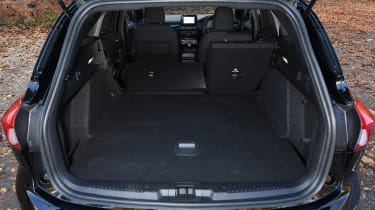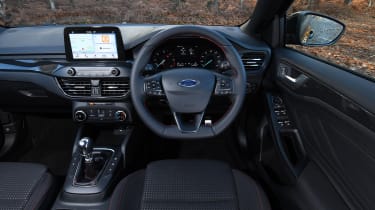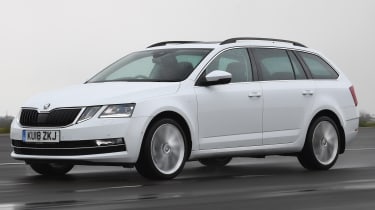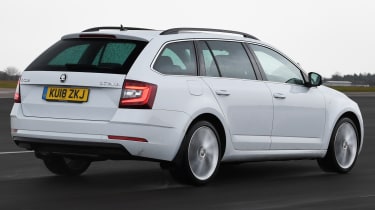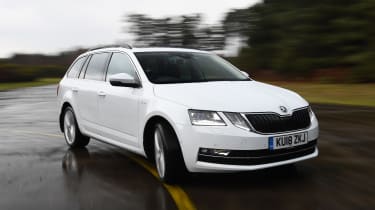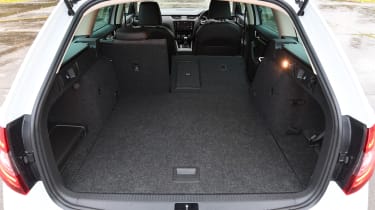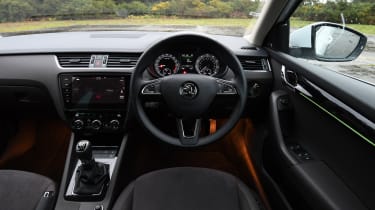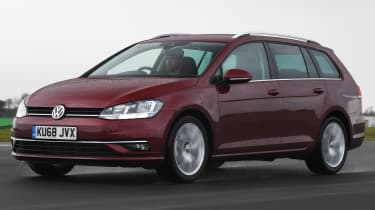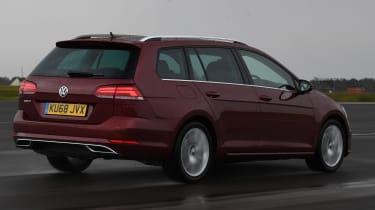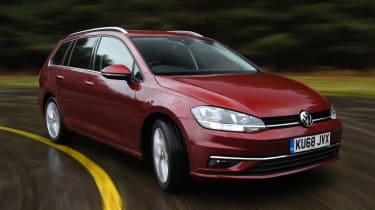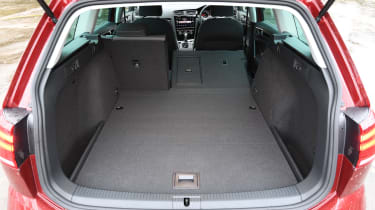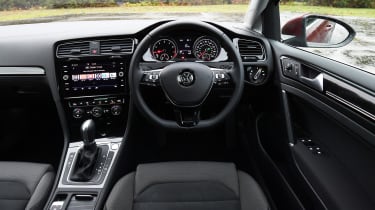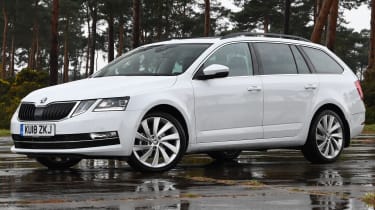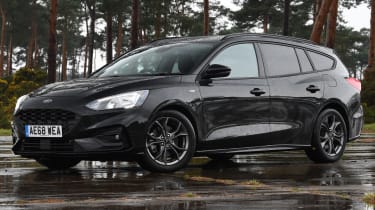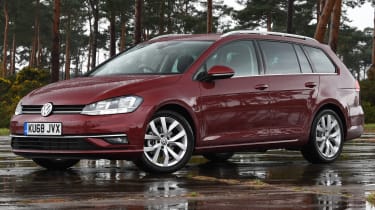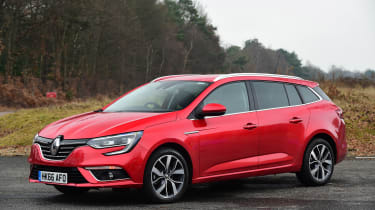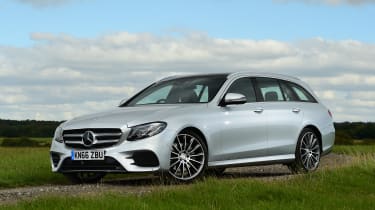Ford Focus Estate vs Skoda Octavia Estate vs VW Golf Estate
Not everyone wants an SUV, so we see if Ford’s practical new Focus Estate can chop down VW and Skoda rivals
With winter in full swing and poor weather inevitable on a daily basis for the next couple of months, it’s easy to assume that an SUV is the perfect kind of car to be driving at this time of year.
But this latest craze in the automotive world is not for everyone – not least because a raised-up crossover or off-roader tends to be more expensive to run than a family estate car. That’s where this trio comes in.
For many buyers, a wagon will be the perfect choice of all-round transport and luckily, there’s a new model on the market: the Ford Focus Estate. As with the Focus hatchback we tested in the autumn, the Estate aims to offer more equipment, more space and a better balance of ride and handling than its predecessor – but that’s not the model it’s got to beat here.
The new Focus narrowly lost out to the Volkswagen Golf in our group test in Issue 1,541, so this time we’ve lined up the Golf Estate to see whether the load-lugging version of the Ford makes more sense.
The car both ultimately have to beat is our current favourite family wagon, the Skoda Octavia Estate. It was crowned Best Estate Car at the Auto Express New Car Awards in 2018, because it offers loads of space and kit at an affordable price. So can the new Ford drive away with a win?
Ford Focus Estate
| Model: | Ford Focus Estate 1.5 TDCi EcoBlue ST-Line |
| Price: | £23,950 |
| Engine: | 1.5-litre 4cyl diesel, 118bhp |
| 0-60mph: | 10.8 seconds |
| Test economy: | 52.3mpg/11.5mpl |
| CO2: | 97g/km |
| Annual road tax: | £140 |
The previous Focus Estate wasn’t a class leader, but this new model addresses the old car’s issues. Here we’re testing the 118bhp 1.5-litre diesel model in ST-Line trim, which costs from £23,950.
Design & engineering
Just like the Mk4 hatch, the new Focus Estate is based on Ford’s latest C2 platform, which uses MacPherson struts for the front suspension, and the rear has a multi-link set-up here. While some lower-powered variants of the Focus hatch use a torsion beam at the back, all Estates feature this more sophisticated system. The wagon gets different dampers from the five-door as well, to help with the extra loads expected to be carried.
Used - available now

2021 Ford
Focus
37,042 milesManualPetrol1.0L
Cash £14,887
2023 Ford
Focus
35,854 milesManualPetrol1.0L
Cash £14,906
2023 Ford
Focus
29,268 milesManualPetrol1.0L
Cash £14,706
2021 Ford
Focus
12,051 milesManualPetrol1.0L
Cash £14,506Our test car uses a 1.5-litre diesel engine with 118bhp, a little more than its test rivals, but the Focus is also heavier than the Skoda and VW. The Octavia and Golf are 118kg and 37kg lighter respectively than the 1,413kg Ford. Still, the Focus is the only car here with a six-speed gearbox; both of its competitors feature five-speed manuals.
The Estate model is also 290mm longer than the hatchback, and it’s also the longest car on test, although only by 1mm over the Skoda.
Inside, the Focus looks more upmarket than its predecessor, too, and while the design isn’t quite as classy as its rivals’, the materials are of good quality. The layout is similar to the smaller Fiesta’s, with the eight-inch infotainment screen on top of the dash.
The screen offers DAB radio, Bluetooth, Android Auto and Apple CarPlay as standard, while ST-Line trim also features 17-inch alloys, keyless operation, air-con and parking sensors. Sat-nav costs £350, though.
Driving
There’s little doubt once you get behind the wheel that the Focus Estate is the best driver’s car here. Not only is the driving position very good, the blend of ride and handling is also excellent. The Ford is comfortable even on rough roads, because the suspension soaks up bumps and ruts in the tarmac very well, especially at higher speeds. You certainly notice that rear suspension layout.
It gives you the confidence to drive the Focus Estate quickly on a typical B-road, where you can enjoy the well-weighted steering and nimble chassis. The Ford is no sports car, and still has some roll in corners, but it’s the most composed and controlled of the three models here, and the most fun to drive, too.
That’s true even though the slightly more powerful engine didn’t translate to better performance at the track. The car went from 0-60mph in 10.8 seconds, 0.8 seconds slower than the Skoda, but only 0.4 seconds behind the VW. The Focus is the heaviest choice of our trio, which partly explains this deficit.
It does feel gutless on the road, although it’s not much worse than its rivals, because all of these cars are focused on economy. The Ford fell in between its competitors from 30-50mph in fourth gear, taking 7.5 seconds, 0.2 seconds behind the Skoda, but 0.3 seconds ahead of the Golf.
The 1.5-litre diesel isn’t the most refined engine, but it’s certainly no harsher than the 1.6-litre TDI shared by the Skoda and VW. Thanks to its extra gear the Focus sits at lower revs at 70mph than the Octavia and Golf, so it’s slightly more relaxed on the motorway, if a little less responsive.
Practicality
This is surely the most important aspect of these three models, and the Ford falls slightly behind its rivals for boot space. With the rear seats in place, the Focus offers a capacity of 575 litres. The Octavia has 610 litres and the Golf 605 litres, although the Ford is almost as usable day to day, plus a space-saver spare wheel adds peace of mind.
However, the fact that the Skoda’s wheelarches don’t cut into the boot space as much makes its load area more usable than the Focus’s when really testing carrying capacity, and in turn, the lower loading lip in the Ford means it’s easier to use than the Golf.
There’s also more rear legroom than in the Volkswagen, although both models are put to shame by the cavernous Octavia, which has by far the most space to stretch out your legs in.
If you go for Ford’s £750 Convenience Pack, you get a rearview camera and door-edge protectors that can help to prevent bumps and scrapes in tight car parks.
Ownership
In our Driver Power 2018 owner satisfaction survey, Ford finished 16th out of 26 in the manufacturers section. This was some way behind VW, which ranked fifth, and Skoda in sixth place overall.
With autonomous braking as well as pedestrian and cyclist detection now standard, plus lane-keep assist and post-collision braking, safety is a strong point for the latest Focus. Euro NCAP awarded the new car its top five-star rating when it was tested in 2018, matching both of its competitors here.
Running costs
Low CO2 emissions of just 97g/km ensure the Focus is the cheapest model here for company car buyers to run.
It sits in the 24 per cent Benefit-in-Kind (BiK) tax bracket, so the Ford estate will cost lower-rate earners £1,140 per year in contributions.
The Skoda runs it close, however, because even though the same buyer will pay £1,335 a year in tax, it has more equipment that you might have to add as options on the Ford, such as sat-nav.
A lower-rate taxpayer will stump up £1,220 a year to run the Volkswagen, and it also comes with satellite navigation, so these three models are very evenly matched for business users.
Testers' notes: "This 1.5-litre diesel is frugal, but even with 118bhp it requires plenty of effort to get up to speed. Long gearing doesn't help, either, because you need to change down all the time to keep your momentum."
Skoda Octavia Estate
| Model: | Skoda Octavia Estate 1.6 TDI SE L |
| Price: | £24,990 |
| Engine: | 1.6-litre 4cyl diesel, 113bhp |
| 0-60mph: | 10.0 seconds |
| Test economy: | 57.5mpg/12.7mpl |
| CO2: | 111g/km |
| Annual road tax: | £140 |
As our reigning Estate Car of the Year, the Skoda Octavia Estate is the model to beat in this test. While our pictures show a high-spec Laurin & Klement variant, we’re testing the £24,990 SE L version because it’s a closer match to the Ford on kit.
Design & engineering
The Octavia was updated in 2017, and is easy to spot thanks to its split headlight design. There weren’t too many changes under the skin, and the Skoda shares many of its mechanical parts with the Volkswagen Golf Estate.
That’s because both use the VW Group’s versatile MQB platform, with Skoda’s model proving how scaleable the architecture is, thanks to its 66mm longer wheelbase when compared with its sibling. The Octavia uses strut suspension at the front and a torsion beam at the rear, while 4x4 models feature a multi-link set-up.
A 1.6-litre diesel engine is shared between the Octavia and Golf, both with 113bhp and 250Nm of torque, which are slightly down on the Ford’s figures. But the Octavia is the lightest car of the three, which helps negate its small power deficit. However, while the Focus has a six-speed manual gearbox, the Skoda makes do with a five-speed transmission.
The Octavia’s interior design is more pragmatic and less interesting than the Ford’s, but it’s elegantly laid out and the materials used tread the line between quality and longevity well, especially with our SE L model’s standard half-leather seats. You get more for your money with the Skoda, because while this specification is more expensive to buy than its rivals, the smarter seats and infotainment give it a more upmarket feel for not much more cash.
SE L spec also brings an eight-inch touchscreen with sat-nav, smartphone connectivity, DAB and Bluetooth, plus 17-inch alloy wheels, LED lights, parking sensors and dual-zone climate control.
Driving
If you’re one of the many estate car buyers who value pragmatism above all else, the Octavia is pretty much spot-on. It’s very easy to drive, with light control weights and a light manual gearshift, while the comfortable ride means it’s very easy to live with.
It serves up strong fuel economy, too, and the icing on the cake is that the Skoda was also the strongest performer here in our track tests.
The Octavia was the fastest car from 0-60mph, taking 10.0 seconds, which was 0.8 seconds faster than the Ford and 0.4 seconds ahead of the VW. It was quickest from 30-70mph through the gears as well, although its 9.6-second time was only 0.1 seconds better than the Golf’s and 0.4 seconds up on the Focus.
All three models can feel slightly underpowered at times, so it’s good to know that the Skoda has a bit of extra firepower should you need it. The Octavia performed well in gear, too, so you don’t have to change ratios too frequently.
All of that contributes to the Czech car’s composed and relaxed feel. The Ford still deals with high-speed bumps better, but the Octavia is refined and quiet at motorway speed. It’s better at smoothing out potholes than the Golf, too, and because there’s enough grip, it’ll carry more corner speed than you might imagine. It’s not as good to drive as the Focus, though, because the steering feels more detached and the driving position is higher up.
Practicality
Practicality is clearly what Skoda’s engineers were focused on when they designed the Octavia, and it remains the best car in its class in this area. For a start, it offers a huge level of boot space, with a total of 1,740 litres available. That puts it ahead of the Focus and Golf, both of which offer 1,620 litres.
But the wide boot opening, flat floor, square load bay and low loading lip all mean the Skoda is by far the most usable of the three cars here, especially in SE L trim, which features a variable-height boot floor as standard. It fulfils the family estate car brief brilliantly, with neat extras such as 12V power in the boot, wheelarch cubbies and luggage hooks.
Rear-seat passengers will find that there’s plenty of head and legroom as well, the most of our three test cars, so there’s no compromise here, either.
Ownership
Skoda has been a consistently high scorer in our Driver Power satisfaction surveys over the years, but in 2018 it only managed sixth place, beaten by Volkswagen in fifth. Ford trailed both in 16th position out of 26 brands.
Still, in the dealer section of our poll, Skoda came eighth, with Volkswagen way down the list in 18th and Ford even further behind in 20th out of 28.
As with both rivals, the Octavia scored five stars in its Euro NCAP crash test, and SE L models come with seven airbags, parking sensors and autonomous emergency braking. Lane-keep assist costs £400 here, while blind spot assist at £400 is cheaper than in its rivals (£500 in the Ford and £1,120 as part of an option pack in the Volkswagen).
Running costs
The Skoda should be very cheap to run, because it returned the best fuel economy of our trio, at 57.5mpg, proving there is life left in clean diesel cars yet. That figure means you’ll spend £1,290 per year on fuel over an average of 12,000 miles annually.
The Ford and Volkswagen weren’t too far behind the Octavia, though. The Focus managed 52.3mpg and the Golf returned 51.4mpg during our time with them. Those figures mean you’ll spend £1,419 at the pumps with the Ford and £1,443 in the Volkswagen over the same 12-month period.
Testers' notes: “Dynamic chassis control costs £870 and adds adaptive dampers to the spec, but the Skoda’s standard set-up is comfy enough, making this nice to have rather than an essential option.”
Volkswagen Golf Estate
| Model: | Volkswagen Golf Estate 1.6 TDI SE Navigation |
| Price: | £23,710 |
| Engine: | 1.6-litre 4cyl diesel, 113bhp |
| 0-60mph: | 10.4 seconds |
| Test economy: | 51.4mpg/11.3mpl |
| CO2: | 108g/km |
| Annual road tax: | £140 |
The Volkswagen Golf is our favourite family hatchback, narrowly beating the Focus in its first test in 2018. Here we’ll find out if it makes as much sense in Estate form and in 1.6 TDI SE Navigation spec. It’s priced from £23,710.
Design & engineering
VW’s current Golf is classed as the Mk7.5. It was updated in 2017, as with the Octavia, but its exterior changes were minimal and the revisions were mainly centred on improving the model’s interior technology.
As with the Skoda, the Golf uses a torsion-beam rear axle, which is less sophisticated than the Focus’s multi-link rear set-up. All three cars here feature strut suspension at the front. Dynamic Chassis Control is available for £850; this adds adaptive suspension that can switch between Comfort, Normal and Sport modes, but as with the Skoda it’s not a must-have.
Also like the Skoda, which is based on the same MQB platform, the VW has a 1.6-litre diesel engine with 113bhp, sending power to the front wheels through a five-speed manual gearbox.
The Golf’s interior is arguably the best of the three cars here, because all the places you regularly touch are made from high-quality plastic, while the design is classier than the Ford’s, even though the Focus is much improved over the previous model.
Here we’re testing SE Navigation trim, which makes the VW the cheapest car of the trio, but it still comes with plenty of kit. Sat-nav is standard, along with an eight-inch touchscreen infotainment system to match its rivals. A set of 16-inch alloys is also fitted, as are adaptive cruise control, some decent safety kit, parking sensors and smartphone connectivity, but not climate control or LED lights.
Driving
The Golf is very impressive from behind the wheel because it serves up a solid blend of ride comfort, body control and composure over bumps at high speed. In Estate form it isn’t quite as compliant as the Focus, but the Volkswagen runs the Ford close and is still more than comfortable enough, while also delivering enough grip to enjoy driving quickly.
Although the Skoda is also slightly softer over bumps than the VW, which will be of more interest to some buyers, the Golf has a great balance of ability. It sits in between its rivals on a scale that goes from the fun-to-drive Ford to the more relaxed Octavia.
The Golf’s steering could do with more feel, because it’s numb, but the weighting is good and it’s precise. The five-speed box has a light, slick shift, too, and the ratios are well spaced. That’s really noticeable next to the Ford, because although that car has a six-speed box, sometimes it can feel like you’re caught in between gears on medium-speed roads.
But while the transmission is good, the 1.6-litre TDI isn’t as refined as the engine in the Focus. Both have an unpleasant diesel grumble at idle and on the move, although the 1.6 is a particularly rattly motor.
At least it develops its maximum power and torque figures lower down in the rev range than the Ford’s 1.5-litre engine, which means changing up early and keeping the revs (and therefore noise) low is easy enough. The VW was well matched with the Ford in gear, because both took 4.6 seconds to go from 30-50mph in third, 0.2 seconds behind the Octavia. The Golf was slightly quicker from 0-60mph than the Ford in our tests, but both were beaten by the Skoda for outright pace.
Practicality
With a capacity of 605 litres, the Golf’s boot trails the Skoda’s, but trumps the Ford’s by 30 litres when the rear seats are in place.
However, the Golf’s boot opening is higher and narrower than its competitors’, so loading big or heavy items will be a little bit harder. Still, there’s no loading lip and the load bay’s floor is flat.
While rear-seat space is plentiful, the VW falls behind the other cars for legroom. It’s brighter in the back of the Golf than in the back of the Ford, but both competitors are dwarfed by the Octavia for passenger space. At least there’s plenty of in-car storage in the Golf, although the central cup-holders block the gearshift if you have a big bottle or cup.
Ownership
In the manufacturers’ chart of our Driver Power 2018 satisfaction survey, Volkswagen came an impressive fifth out of 26 brands, so there’s plenty of consumer confidence in the German brand.
As with both rivals, the Golf scored five stars in its Euro NCAP crash test, and with autonomous braking, parking sensors and seven airbags fitted as standard, it matches its rivals for safety kit.
However, safety options are pricier, with lane-keep assist costing £550, for example, when it’s £400 on the Octavia and comes as standard on the Focus. To get blind spot detection you’ll have to buy a £1,120 option pack, although lane-keep assist, traffic jam assist and traffic sign recognition are all included.
Running costs
The Golf is the cheapest car to buy in this test, and Volkswagen’s traditionally strong residual values mean it will lose the least money after three years or 36,000 miles.
Over that period our experts predict it will shed £13,484 (a residual value of 43.1 per cent), while the pricier Ford Focus Estate will lose a predicted £13,776, with a slightly lower residual value of 42.5 per cent.
The Skoda depreciates a little more than its competitors, losing an estimated £14,714 of its list price. Its residual value is predicted at 41.1 per cent.
Testers' notes: “An automatic gearbox is available on all three of our test models, but the manual versions represent much better value for money and all three are sweet to use.”
Verdict
First place: Skoda Octavia Estate
The Octavia retains its crown as the best family estate car around. It could be the best estate you can buy, full stop. It offers great value because it comes with loads of standard kit and a huge level of space inside. The Skoda is also good to drive, comfortable and cheap to run. Its extra performance will help with carrying heavy loads, while the plentiful rear legroom will be a hit with kids.
Second place: Ford Focus Estate
Great to drive yet still comfortable and compliant: that’s the Focus Estate’s key strength. It’s also practical, with plenty of usable boot space, and will be almost as cheap as the Skoda to run. That’s especially true for company car buyers, thanks to the Ford’s very low emissions. It beats the Golf here for that reason, while its cabin is roomier, too.
Third place: Volkswagen Golf
VW’s Golf Estate doesn’t make as convincing a case as the hatch version, so it loses out to the Focus here. It’s not quite as good value as its rivals in this test despite being a little cheaper, especially because the options are pricey and it’s a little less practical. But the Golf still makes an excellent family car, because it’s comfy, refined and good to drive.
Also consider...
New: Renault Mégane Sport Tourer 1.5 dCi GT Line
Price: £22,875Engine: 1.5-litre 4cyl, 108bhp
The Renault Mégane is arguably the most stylish estate, which will be a big draw for many people. But it has substance, too, with an economical diesel engine, a big boot and a pleasant interior.
Used: Mercedes E 220 d SE Estate
Price: £22,999Engine: 2.0-litre 4cyl, 191bhp
If you want more luxury and load space, you can do it on a modest budget. We found a 2017 Mercedes E-Class Estate with 15,000 miles for just under £23,000, which looks like great value.
